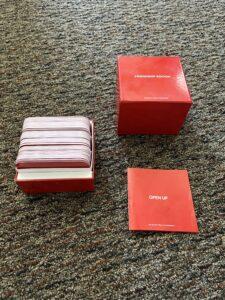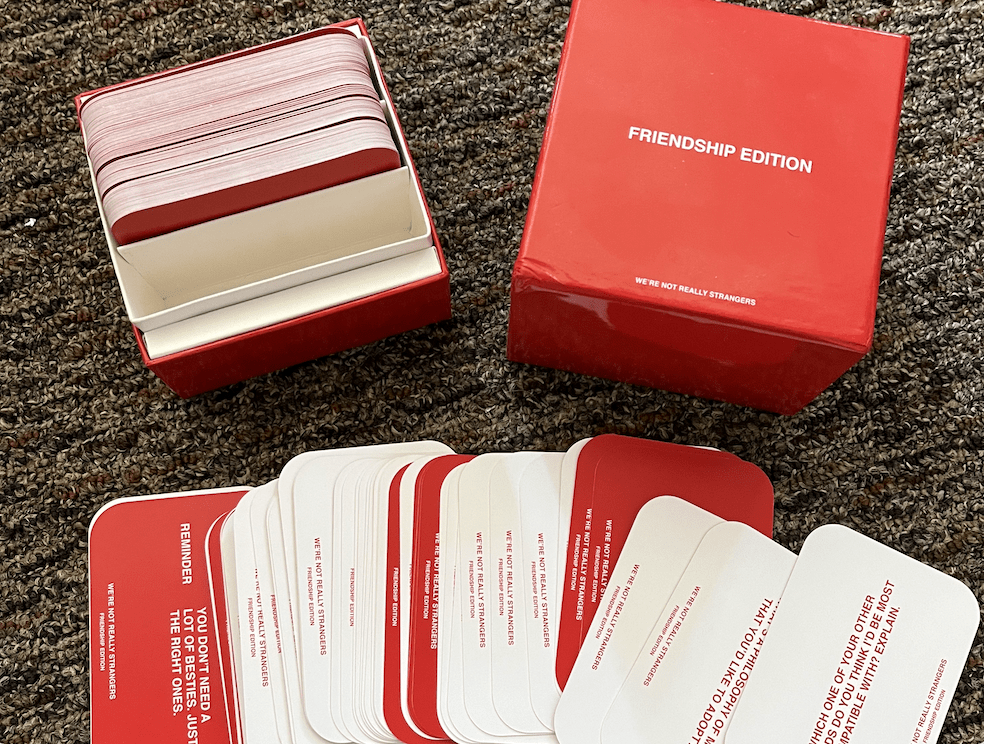About the Game
This week I played We’re Not Really Strangers (the Friendship Edition) with a group of friends using a deck that my roommate owns. The game began as a concept through a series of viral Instagram posts by a woman named Koreen Odiney, but it now exists as a physical pack of cards that a consumer can buy in stores. Because of the strong tie to social media, the target demographic for this game is definitely Millennials and Gen Zers, but the basic premise is aimed at anyone who feels the desire to strengthen or deepen the relationships that they have with those around them. In fact, years ago when Ordiney was asked when why she wanted to develop this game, she stated, “To empower people to make meaningful connections”.
Game Mechanics

The box says that the game can be played with two to six players, but I believe that there could be a couple more people added while maintaining the fun and intimacy of the game. At a certain point, the group size would grow too large, but I do believe eight or nine people could easily enjoy playing together. The game is extremely simple, with only one action that players are able to take: drawing a card and answering it/following the instructions. There are three levels of cards, so the game takes place in three rounds and players in round one choose a level one card, players in round two choose a level two card, etc. As the levels increase, the questions/prompts grow deeper and more intimate. Additionally, the game mechanics slightly change as the levels increase. In level one, a player chooses a card and the player to the left of him or her has to answer, but in level two, a player chooses a card and then chooses who they want to answer it. This adds a greater feeling of camaraderie and increases the fellowship. This happens again in round three in which a player draws a card and everyone else in the group collectively answers for that person. This increases the intimacy of the game and helps cultivate a feeling of community and togetherness.
Why It’s Fun!

We’re Not Really Strangers very clearly relies on fellowship for fun due to the social nature of the game, but I would argue that there are some other contributors as well. The game cards are extremely clean and visually appealing, which I think adds a level of fun as sensation. Additionally, because each player is learning things about the other players in the group from the answers to their questions, this game involves fun as discovery. This game is extremely successful at what it’s aiming to do because level one cards serve almost as a warm-up, with surface-level questions that don’t take much vulnerability to answer. This makes it so as the game goes on, players are answering increasingly more personal questions, but they’re eased into it gently. In my experience playing, however, I did feel that there was a bit of a discrepancy in the intensity of the questions within each level. For example, during level three, one of my friends drew the card “What limiting belief do you think is holding me back the most?” while another one of my friends drew the card “What inside joke of ours will never stop being funny?”. Objectively the first question has much more depth to it, so I think more thought should have gone into standardizing the type of question within each level.
One small critique that I have for this game is that the instructions direct players to move onto level two only after all cards in level one have been answered. Although the questions in level one are oftentimes quite easy to answer, the process of getting through all of them still takes a bit of time. The same goes for level two, and, as a result, by the time my group got to level three we were getting tired of playing and so we cut the last round short. The game is designed such that level three should be the most important round since it requires players to be the most vulnerable, so I think it was a mistake on their part not to anticipate the burnout that many people would be feeling when they get there. I think that the game could be improved by reducing the amount of level-one cards or directing each player to only answer four or five of them.



